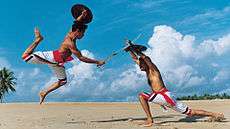Paika akhada
| Part of a series on |
| Indian martial arts |
|---|
 |
| Styles |
|
| Legendary Figures |
| Notable Practitioners |
| Related terms |
Paika akhada or paika akhara is an Odia term which roughly translates as "warrior gymnasium" or "warrior school".[1] In former times they served as the training schools of the peasant militia in Odisha, eastern India. Today's paika akhada are used for practicing the traditional physical exercises in addition to the paika dance, a performance art with rhythmic movements and weapons being hit in time to the drum. It incorporates acrobatic maneuvres and use of the khanda (straight sword), patta (guantlet-sword), sticks, and other weapons.
The word paika comes from the Sanskrit padatika meaning infantry. "Akhada" or akhara refers to a training hall, or in this case referring to a particular string of such schools. The former spelling is an alternate transcription of the proper Sanskrit akhara in which the Oriya letter ଡ଼ ṛ, a flapped [ɽ] sound, is rendered as d.
History
Paika akhada were originally the training schools of the paika class of warriors. The paika were a landed militia who were exempted from taxes in lieu of their services. They were not in the regular pay-roll of the army, but still received large land grants from the king. A peasant militia, the paika's main source of income was agriculture. They were organised into three ranks distinguished by their occupation and the weapons they wielded. These were the Pahari, bearers of shields and the khanda (sword), the Banua who led distant expeditions and the Dhenkiya - archers who also performed different duties in armies.[2] The paika were led by a particular caste of kshatriya called the Khandayat. The word itself means "sword controller", from khanda (sword) and ayata (control).[1] Commanders called Dala Beheri were each in charge of several villages of paika.
In times of peace the paika served as law enforcement, and the paika akhada were used to keep the warrior class physically and mentally fit.[3] Kharavela of ancient Kalinga relied on the military might of the paika in his campaigns.[4] The paika and khandayat reached their zenith of power during the Gajapati Dynasty,[1] and were known as far as Indonesia. During the Muslim period, the kingdom was powerful enough to threaten the Islamic rule of Bengal, but the invaders did not dare attack Odisha due to the paika's reputation.
The paika lost their power and prestige in the early 19th century under British rule. Discontent over the East India Company's policies resulted in the Paika Rebellion of 1817, wherein the former baxi (commander) Jagabandhu Bidyadhar Mohapatra Rai lead 400 paika in revolting against British rule. The rebels sacked the civil buildings and treasury in Khurda, killing officials of the Company. British forces sent to quell the rebellion were met with sustained attacks from the paika. The British commander of one detachment was killed during a battle at Gangpada. They defended the Barunei Fort at Khurda which is thought to be the last free fort in India to be conquered by the British. The paika managed to capture the southern portion of Odisha, and the rebellion lasted a year before it was put down. To ensure such a revolt would not repeat itself, the colonists undertook vigorous steps to stamp out the martial practices of Odisha.
Khandayat families preserved the paika akhada through annual performances.[5] This has continued to the present day, but the tradition is increasingly uncommon. Once exclusive to men, Soubaghini Debi became the first female performer a few decades ago, opening the art to both genders. Paika akhada are increasingly rare in Odisha today and the plight of its artistes have been highlighted in the state.[6] To conserve and promote the art, the government of Odisha has proposed to establish a Paika Akhada Academy in the Gajapati district.[5] The art is performed along with other war-dances and fighting styles during the annual Kalinga Mahotsav festival at the Vishwa Shanti Stupa.
Performance
Descendants of the paika practice at their local akhara every day after work. Demonstrations are arranged every year for the Dasara festival and other occasions. The grounds are first prepared with soft earth sprinkled with oil and water. The performers stand in two rows with wooden swords and shields. They approach each other slowly before the tempo of the music increases, at which point they engage in mock combat.
References
- 1 2 3 "Paika Akhada". Indian Association of Kickboxing Organisations. Retrieved 9 February 2013.
- ↑ Mohanty, N.R. (August 2008). "The Oriya Paika Rebellion of 1817" (PDF). Orissa Review: 1–3. Retrieved 13 February 2013.
- ↑ "'Paika Akhada' performance wows all". The Hindu. November 22, 2010. Retrieved 9 February 2013.
- ↑ http://orissa.gov.in/e-magazine/orissaannualreference/ORA-2004/pdf/martial_tradition_of_orissa.pdf
- 1 2 "Paika Academy to be set up". The Hindu. October 10, 2008. Retrieved 9 February 2013.
- ↑ "Pulsating performances". The Hindu. March 28, 2008. Retrieved 9 February 2013.